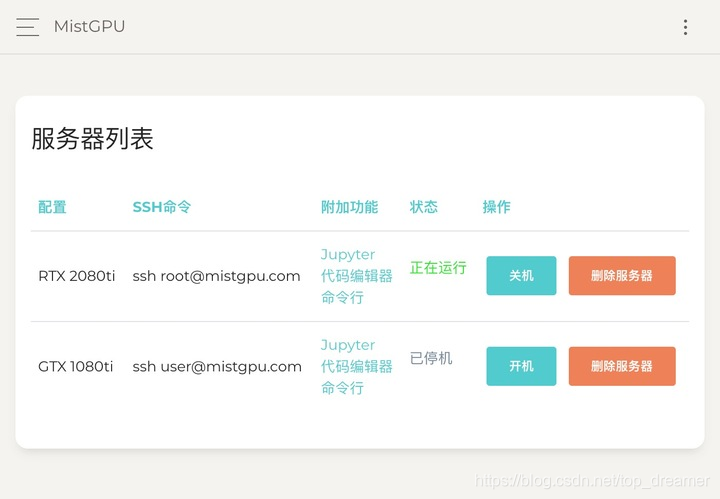推荐适合学生党做深度学习使用GPU的平台(薅羊毛)
本文共 203 字,大约阅读时间需要 1 分钟。
推荐适合学生党做深度学习使用GPU的平台(薅羊毛)
 如果小伙伴在实验室一块GPU都没有怎么做深度学习?那我推荐下MistGPU平台,使用特别方便,传输文件速度也特别快(存储文件1G以下免费),可以按需使用,使用量比较大的也可以联系客服按月使用。我目前在使用ing!注册就有免费试用,每邀请一个用户也有赠送使用8元金额,无上限!欢迎一起薅羊毛(链接如下)~
如果小伙伴在实验室一块GPU都没有怎么做深度学习?那我推荐下MistGPU平台,使用特别方便,传输文件速度也特别快(存储文件1G以下免费),可以按需使用,使用量比较大的也可以联系客服按月使用。我目前在使用ing!注册就有免费试用,每邀请一个用户也有赠送使用8元金额,无上限!欢迎一起薅羊毛(链接如下)~ 截图展示我目前正在使用的gtx1080ti的机器:

转载地址:http://vogs.baihongyu.com/
你可能感兴趣的文章
ng build --aot --prod生成文件报错
查看>>
ng 指令的自定义、使用
查看>>
ng6.1 新特性:滚回到之前的位置
查看>>
nghttp3使用指南
查看>>
Nginx
查看>>
nginx + etcd 动态负载均衡实践(一)—— 组件介绍
查看>>
nginx + etcd 动态负载均衡实践(三)—— 基于nginx-upsync-module实现
查看>>
nginx + etcd 动态负载均衡实践(二)—— 组件安装
查看>>
nginx + etcd 动态负载均衡实践(四)—— 基于confd实现
查看>>
Nginx + Spring Boot 实现负载均衡
查看>>
Nginx + Tomcat + SpringBoot 部署项目
查看>>
Nginx + uWSGI + Flask + Vhost
查看>>
Nginx - Header详解
查看>>
nginx - thinkphp 如何实现url的rewrite
查看>>
Nginx - 反向代理、负载均衡、动静分离、底层原理(案例实战分析)
查看>>
Nginx - 反向代理与负载均衡
查看>>
nginx 1.24.0 安装nginx最新稳定版
查看>>
nginx 301 永久重定向
查看>>
nginx 403 forbidden
查看>>
nginx connect 模块安装以及配置
查看>>